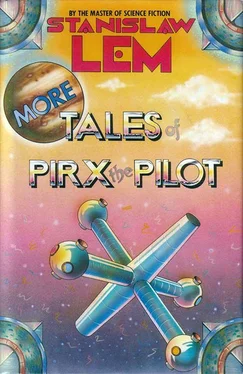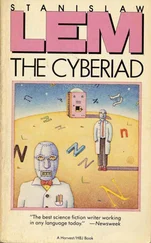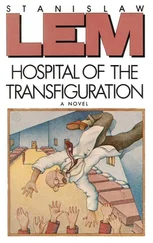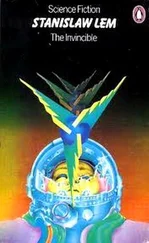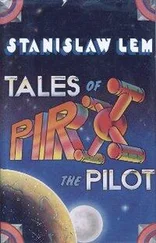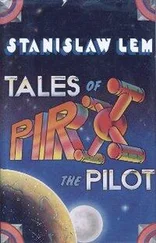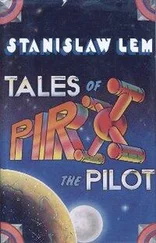“The name suggests mythology, but it’s only an acronym, from Self-programming Electronic Ternary Automaton Racemic, racemic since in the construction of its brain we use both dextro- and levorotatory monopolymer pseudo crystals. But I guess that’s not important here. It is an automaton equipped with a laser for mining operations, a violet laser; the energy to emit the impulses is supplied it by a micropile, working on the principle of a cold chain reaction, so that the Setaur—if I remember correctly—can put out impulses of up to forty-five thousand kilowatts.”
“For how long?” someone asked.
“From our point of view, forever,” immediately replied the thin scientist. “In any case for many years. What exactly happened to this Setaur? In plain language, I think it got hit over the head. The blow must have been unusually strong, but, then, even here a falling building could damage a chromium-nickel skull. So what took place? We’ve never conducted experiments of this kind; the cost would be too great”—McCork gave an unexpected smile, showing small, even teeth—“but it is generally known that any sharply localized damage to a small, that is, relatively simple, brain or ordinary computer results in a complete breakdown in function. However, the more we approximate the human brain by imitating its processes, then the greater the degree to which such a complex brain will be able to function despite the partial damage it has suffered. The animal brain—a cat’s brain, for example—contains certain centers, the stimulation of which produces an attack response, manifested as an outburst of aggressive rage. The brain of the Setaur is built differently, yet does possess a certain general drive, a potentiality for action, which can be directed and channeled in various ways. Now, some sort of short circuit occurred between that motive center and an already initiated program for destruction. Of course I am speaking in grossly oversimplified terms.”
“But why destruction?” asked the same voice as before.
“It is an automaton designed for mining operations,” Dr. McCork explained. “Its task was to have been to dig levels or drifts, to bore through rock, to crush particularly hard minerals—broadly speaking, to destroy cohesive matter, obviously not everywhere and not everything, but as a result of its injury such a generalization came about. Anyway, my hypothesis could be completely wrong. That side of the question, the purely theoretical, will be worth considering later, after we have made a carpet of the thing. At present it is more important for us to know what the Setaur can do. It can move at a speed of about fifty kilometers an hour, over almost any terrain. It has no lubricating points; all the friction-joint surfaces work on teflon. Its suspensions are magnetic, its armor cannot be penetrated by any revolver or rifle bullet. Such tests have not actually been made, but I think that possibly an antitank gun… Of course, we don’t have any of those, do we?”
Achanian shook his head. He picked up the list that had been returned to him and read it, making little marks beside the names.
“Obviously, the explosion of a fair-sized charge would pull it apart,” McCork went on calmly, as if he were talking about the most ordinary things. “But first you would have to bring the charge near it, and that, I am afraid, will not be easy.”
“Where exactly does it have its laser? In the head?” asked someone from the audience.
“Actually it has no head, only a sort of bulge, a swelling between the shoulders. That was to increase its resistance to falling rock. The Setaur measures two hundred twenty centimeters in height, so it fires from a point about two meters above the ground; the muzzle of the laser is protected by a sliding visor; when the body is stationary it can fire through an angle of thirty degrees, and a greater field of aim is obtained when the entire body turns. The laser, as I said, has a maximum power of forty-five thousand kilowatts. Any expert will realize that this is considerable; it can easily cut through a steel plate several centimeters thick…”
“At what range?”
“It’s a violet laser, therefore with a very small angle of divergence from the line of incidence. So the range will be, for all practical purposes, limited to the field of vision; since the horizon here on a level plane is at a distance of two kilometers, two kilometers at the very least will be the range of fire.”
“We will be receiving special mining lasers of six times that power,” Achanian put in.
“But that is only what the Americans call overkill,” McCork replied with a smile. “Such power will provide no advantage in a duel with the Setaur’s laser.”
Someone asked whether it wouldn’t be possible to destroy the automaton from aboard some cosmic vessel. McCork declared himself not qualified to answer; Achanian meanwhile glanced at the sign-up sheet and said:
“We have here a navigator first class. Pirx … would you care to comment on this?”
Pirx got up.
“Well, in theory, a vessel of medium tonnage like my Cuivier, which has a sixteen-thousand-ton rest mass, could certainly destroy such a Setaur, if it got it in its line of thrust. The temperature of the exhaust gases exceeds six thousand degrees for a distance of nine hundred meters. That would be sufficient, I think…?”
McCork nodded.
“But this is sheer speculation,” Pirx continued. “The vessel would have to be somehow brought into position, and a small target like the Setaur, which really isn’t any larger than a man, could always have time to move out of the way, unless it were immobilized. The lateral velocity of a vessel maneuvering near the surface of a planet, within its field of gravity, is quite small; sudden pursuit maneuvers are completely out of the question. The only remaining possibility, then, would be to use small units, say, the Moon’s own fleet. Except that the thrust here would be weak and of not very high temperature, so perhaps if you used one of those crafts as a bomber instead… But for precision bombing you need special instruments, sights, range-finders, which Luna Base doesn’t have. No, we can rule that out. Of course it will be necessary, even imperative, to employ such small machines, but only for reconnaissance purposes—that is, to pinpoint the automaton.”
He was about to sit down when suddenly a new idea hit him.
“Oh, yes!” he said. “Jump holsters. Those you could use. I mean—you would have to have people who knew how to use them.”
“Are they the small, individual rockets one straps on over the shoulders?” asked McCork.
“Yes. With them you can execute jumps or even sail along without moving; depending on the model and type, you get from one to several minutes aloft and reach an altitude of fifty to four hundred meters.”
Achanian stood.
“This may be important. Who here has been trained in the use of such devices?”
Two hands went up. Then another.
“Only three?” said Achanian, “Ah; you, too?” he added, seeing that Pirx, who now saw what was coming, had also raised his hand. “That makes four. Not very many… Well ask among the ground crew. Gentlemen! This is—it goes without saying—strictly a voluntary mission. I really ought to have begun with that. Who wants to take part in the operation?”
A slight clatter ensued, for everyone present was standing up.
“On behalf of Control, I thank you,” said Achanian. “This is fine… And so we have seventeen volunteers. We will be supported by three units from the lunar fleet, and in addition will have at our disposal ten drivers and radio operators to help man the transporters. I will ask you all to remain here, and you”—he turned to McCork and Pirx—“please come with me, to Control.”
Читать дальше
